Secondary pulmonary hypertension (PH) is a serious complication of end-stage lung disease and is associated with unfavorable prognosis. The aim of the study was to evaluate the incidence and severity of secondary PH among patients qualified for lung transplantation (LTx).
The study population consisted of 143 patients qualified for LTx between 2004 and 2019. Analyzed medical records included results collected during the qualification process (eg, echocardiography parameters, right heart catherization [RHC]). There were 37.8% (n = 54) of patients with chronic obstructive pulmonary disease (COPD), 58.7% (n = 84) of patients with interstitial lung diseases (ILDs), and 3.5% (n = 5) of patients with combined pulmonary fibrosis and emphysema (CPFE). The inclusion criteria were ILDs, COPD or CPFE diagnosis, and the presence of RHC data preformed during qualification for LTx. The exclusion criteria were lack of RHC results and diagnosis of idiopathic pulmonary artery hypertension, pulmonary artery hypertension associated with connective tissue disease, cystic fibrosis, or bronchiectasis.
PH was detected among 60.1% (n = 86) of patients qualified for LTx. The prevalence of PH was 39% (n = 18) vs 76.19% (n = 64) in the COPD vs ILDs groups, respectively. Both ILDs and COPD patients presented with similar mean artery pulmonary pressure (36.3 ± 9.61 vs 34.78 ± 11.47 mm Hg; not statistically significant). Severe PH was more frequent in the ILDs group than in the COPD group (60.94% vs 38.89%).
PH is commonly diagnosed in patients with chronic lung diseases qualified for LTx and more often observed among patients qualified because of ILDs. It is important to assess the pulmonary pressure because of frequent occurrence of PH among patients referred for LTx.
Copyright © 2020 The Authors. Published by Elsevier Inc. All rights reserved.
Secondary Pulmonary Hypertension Among Patients Qualified for Lung Transplantation: Single-Center Study.


